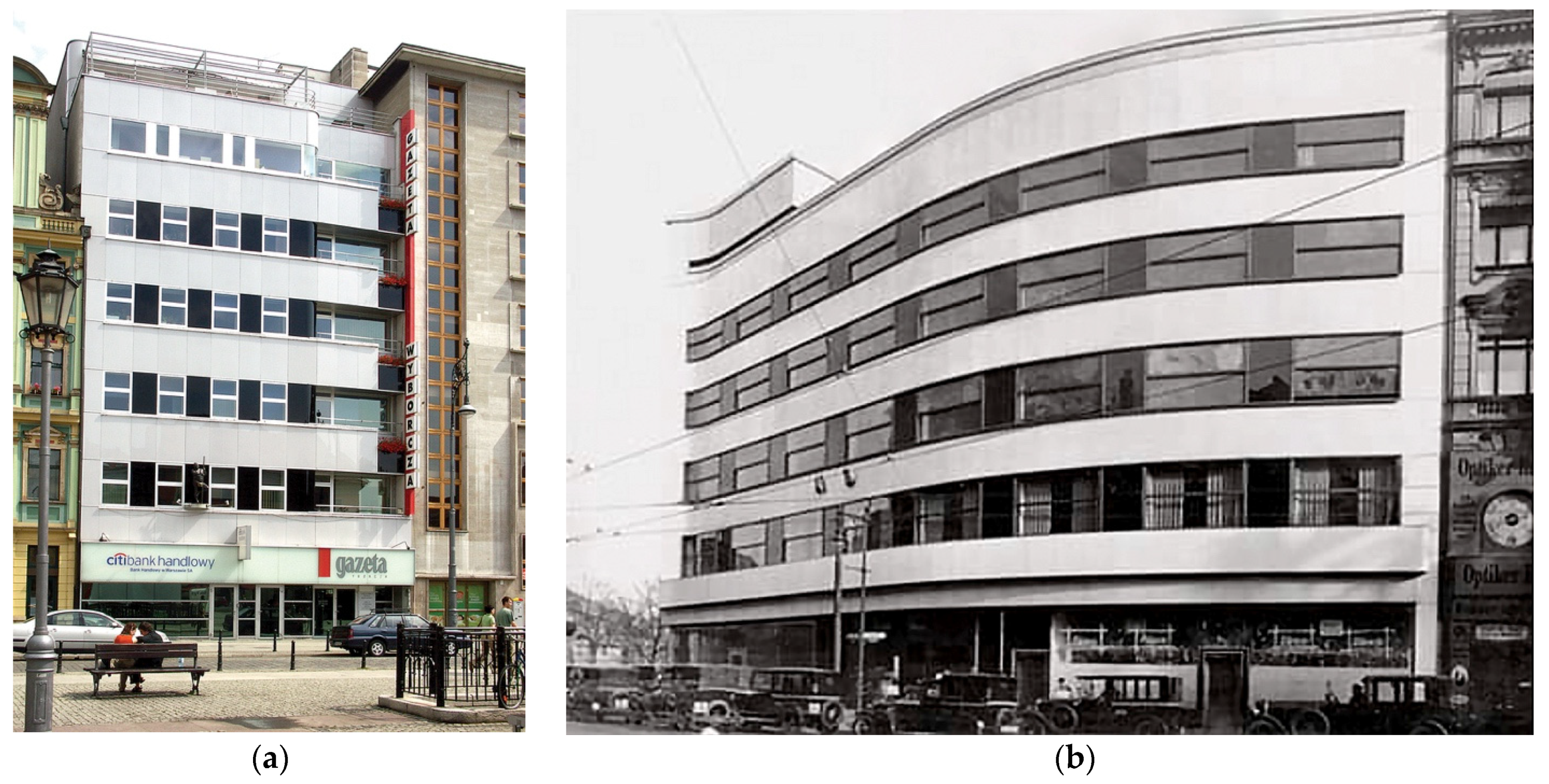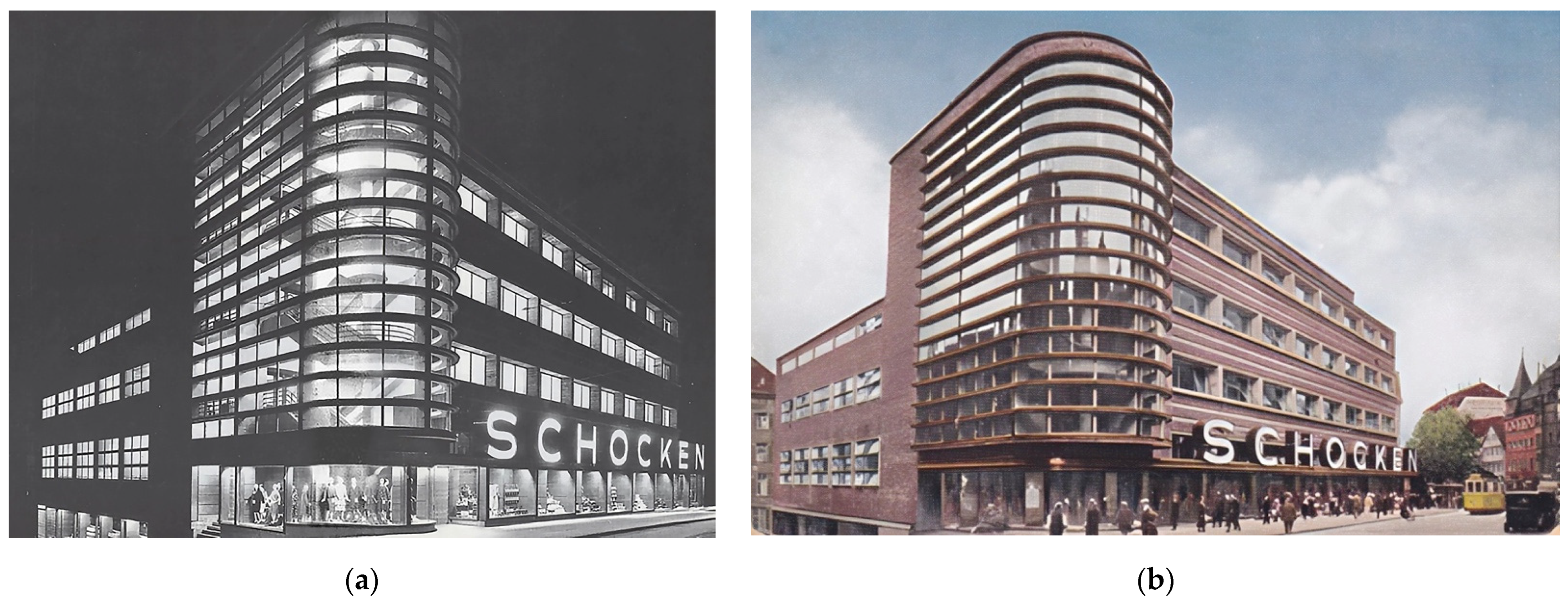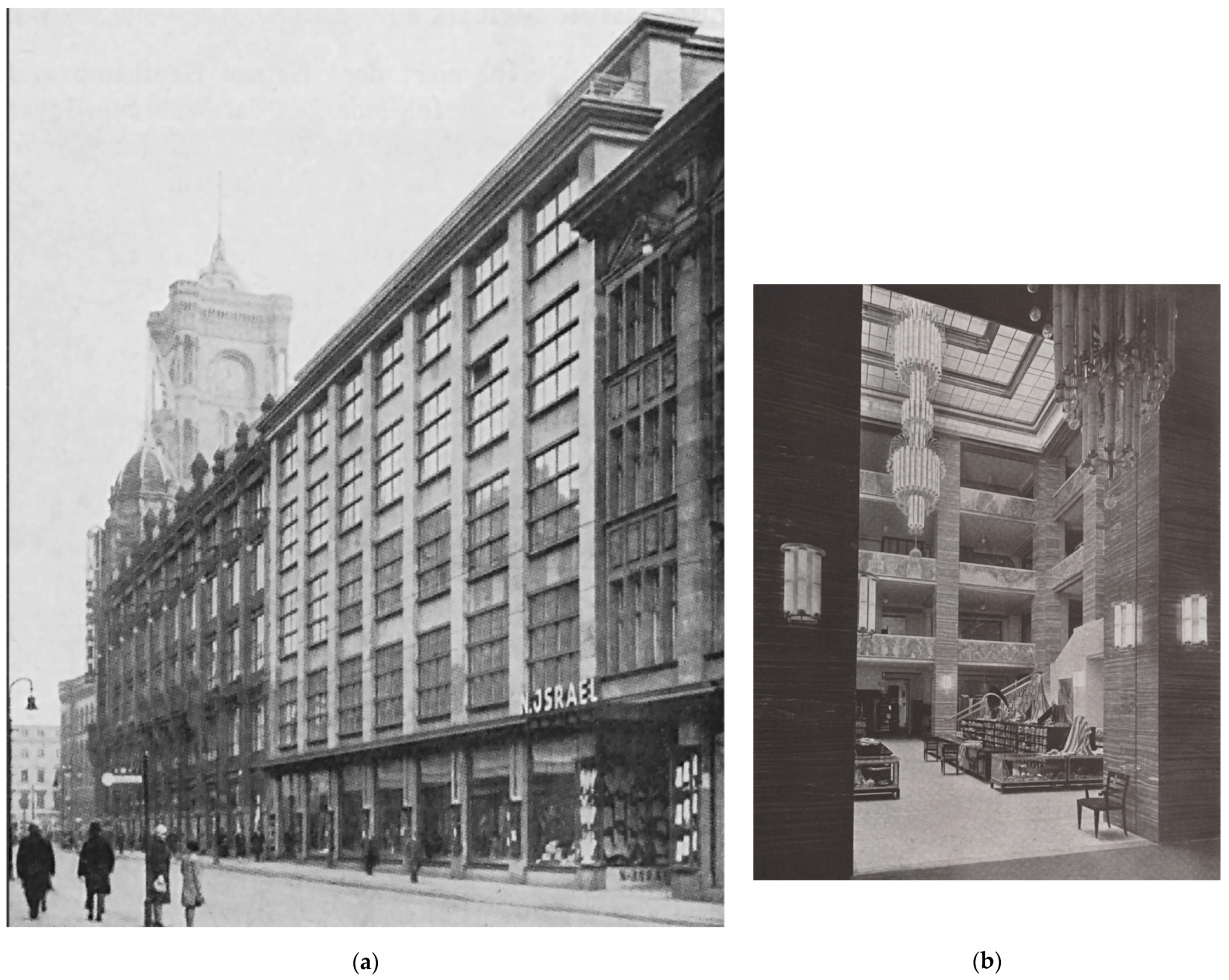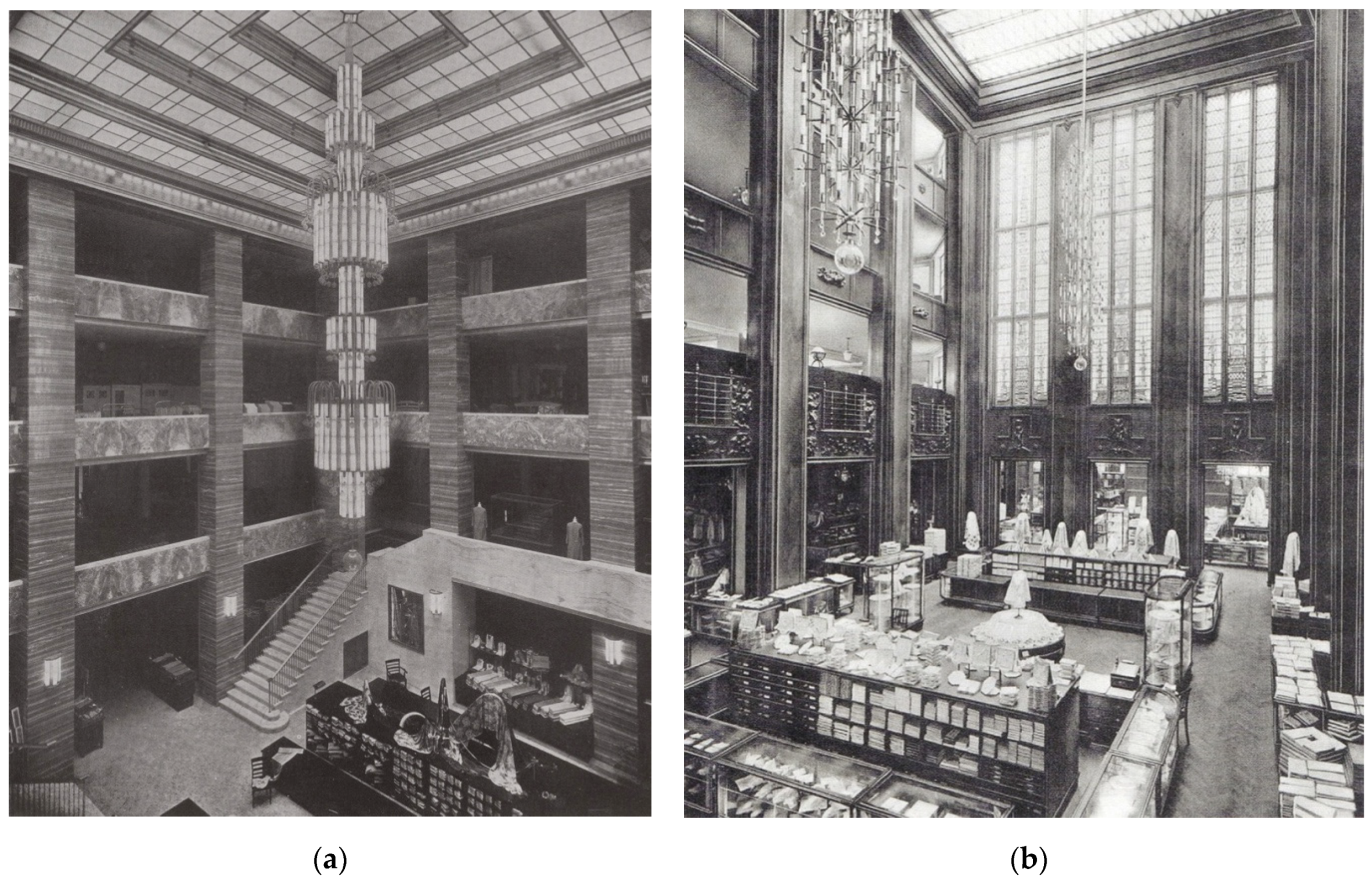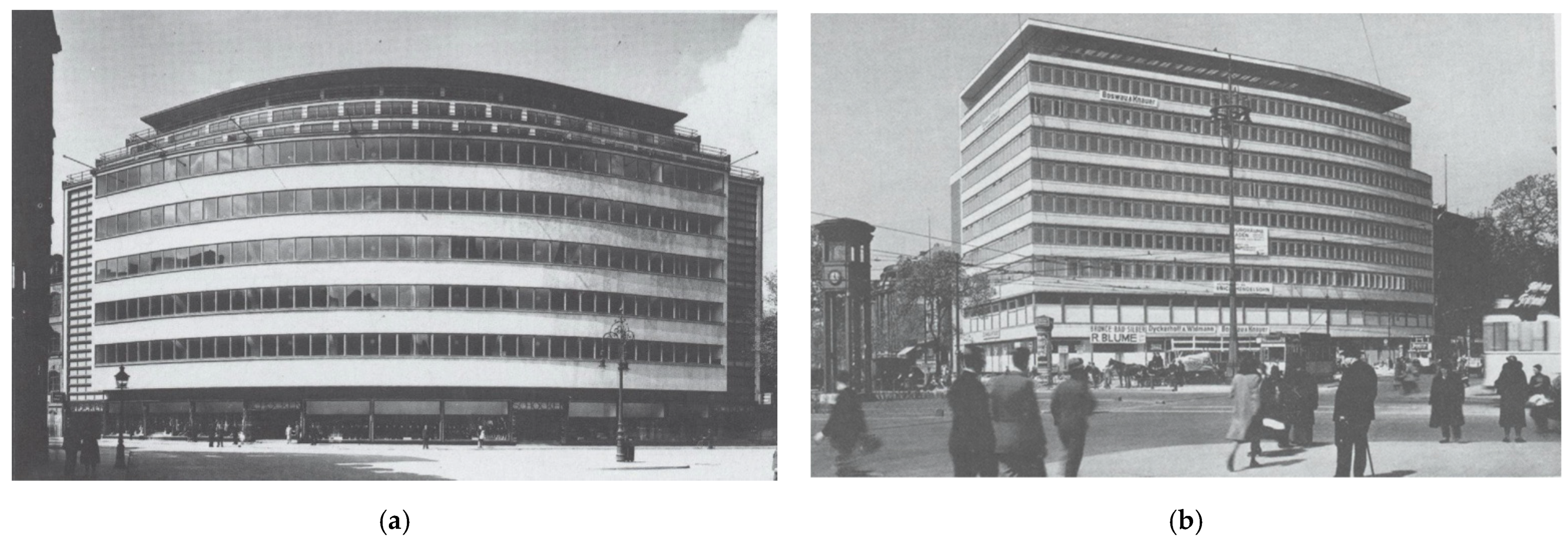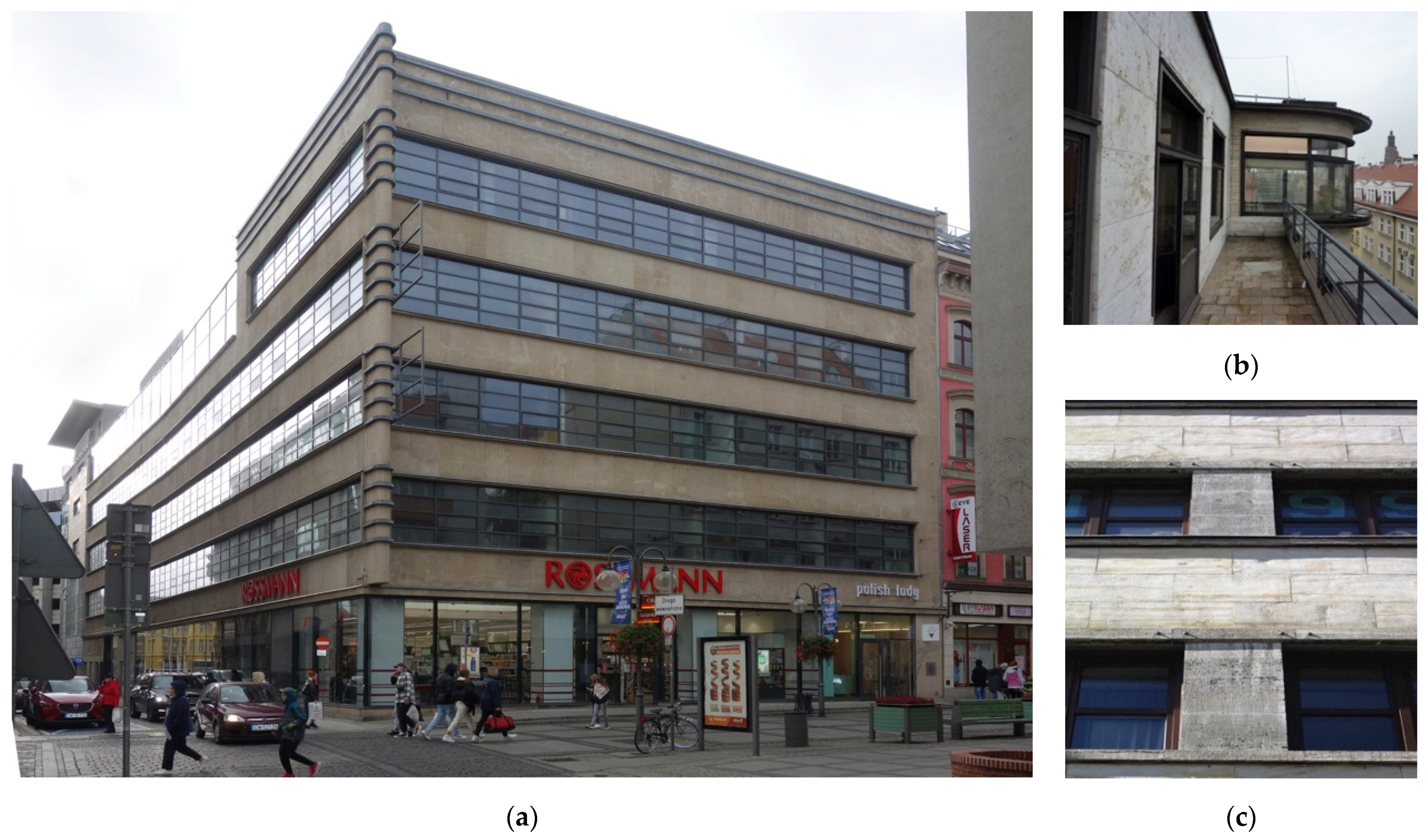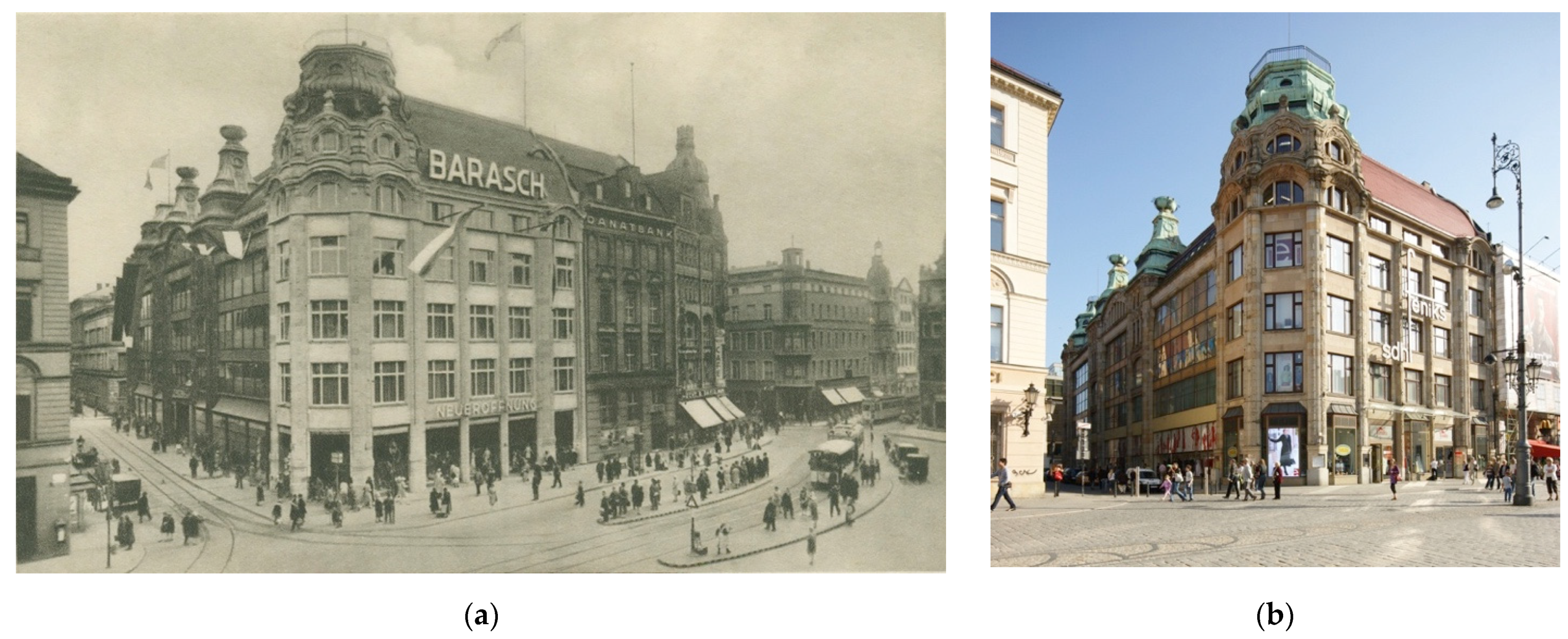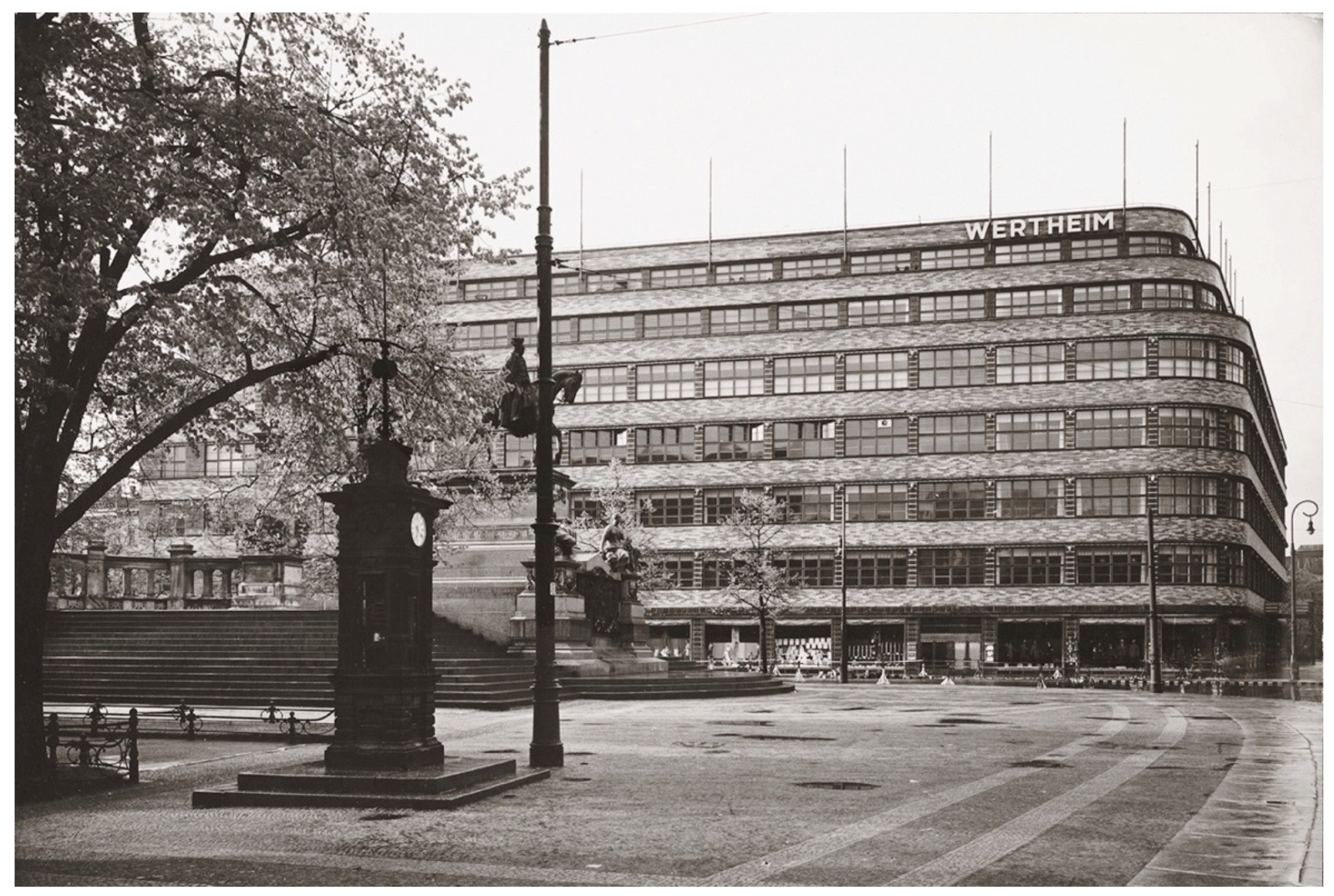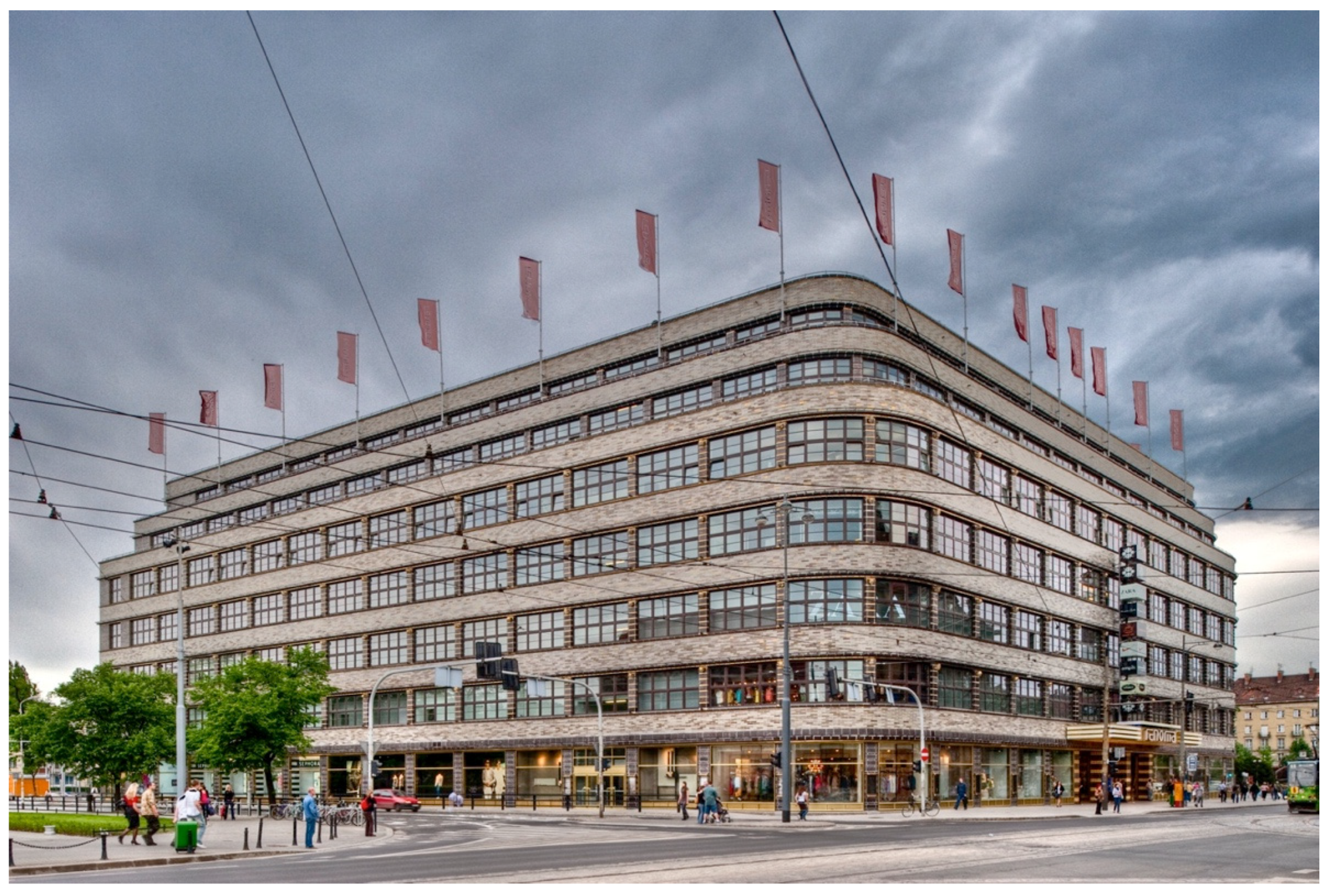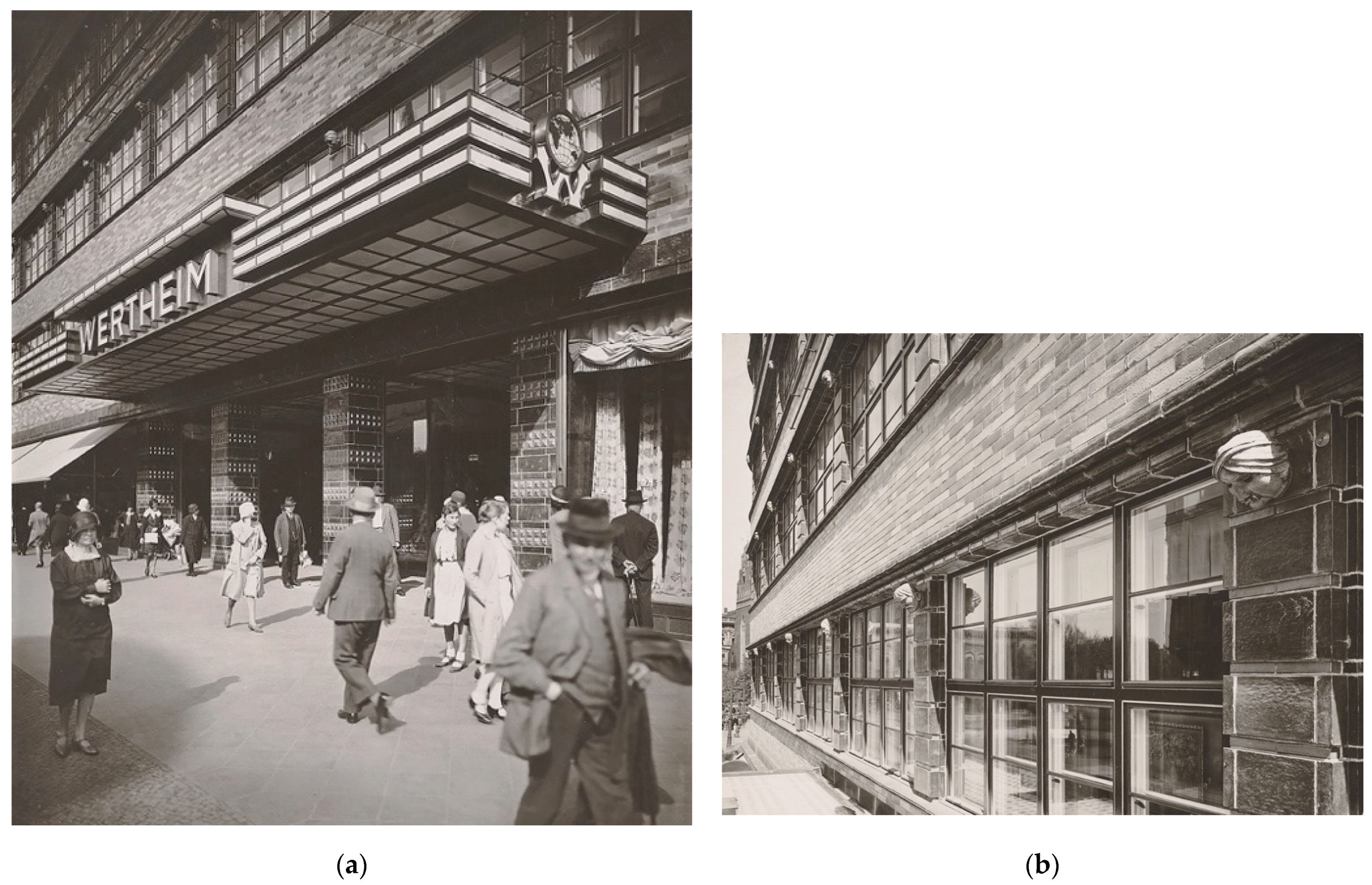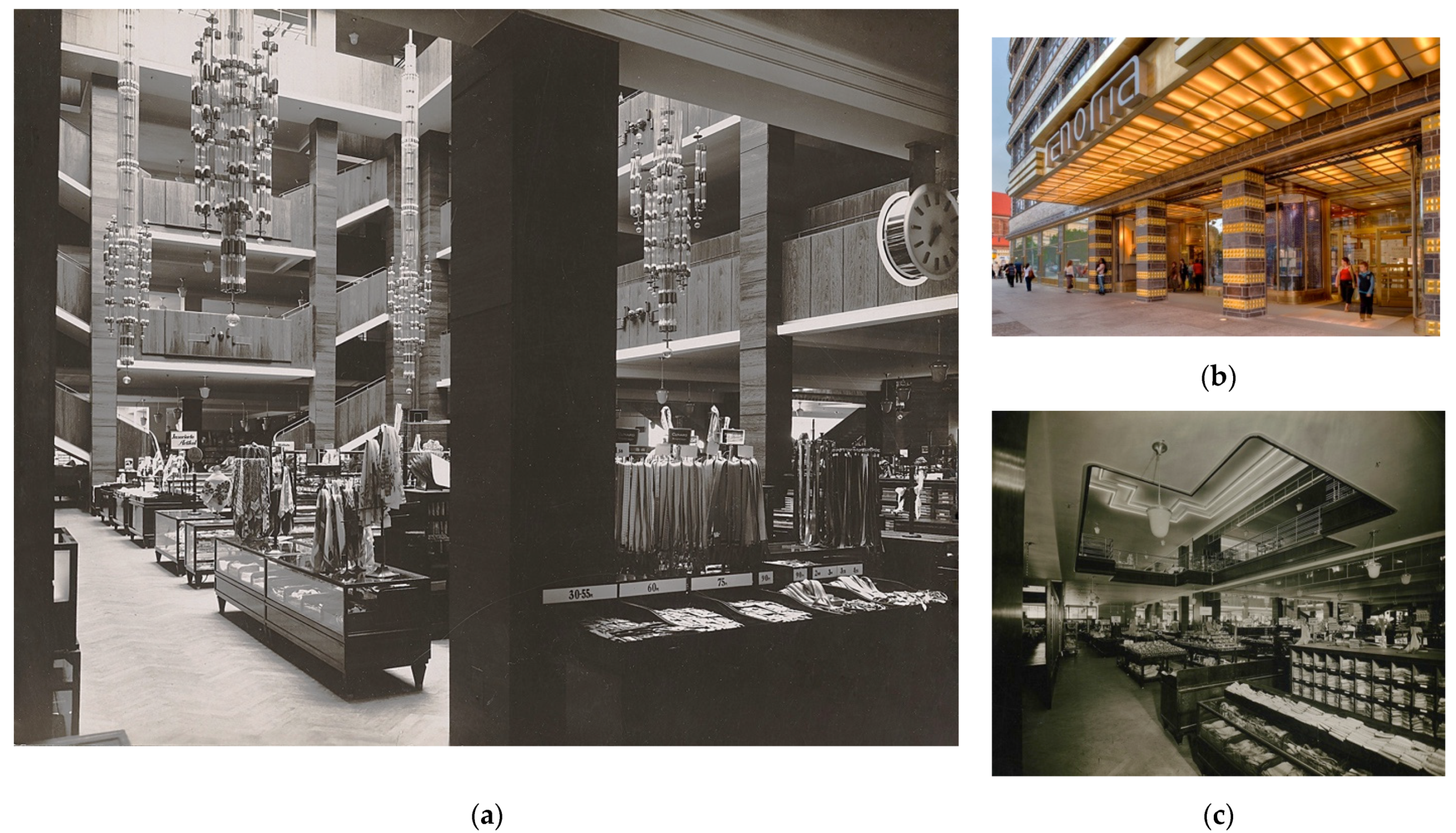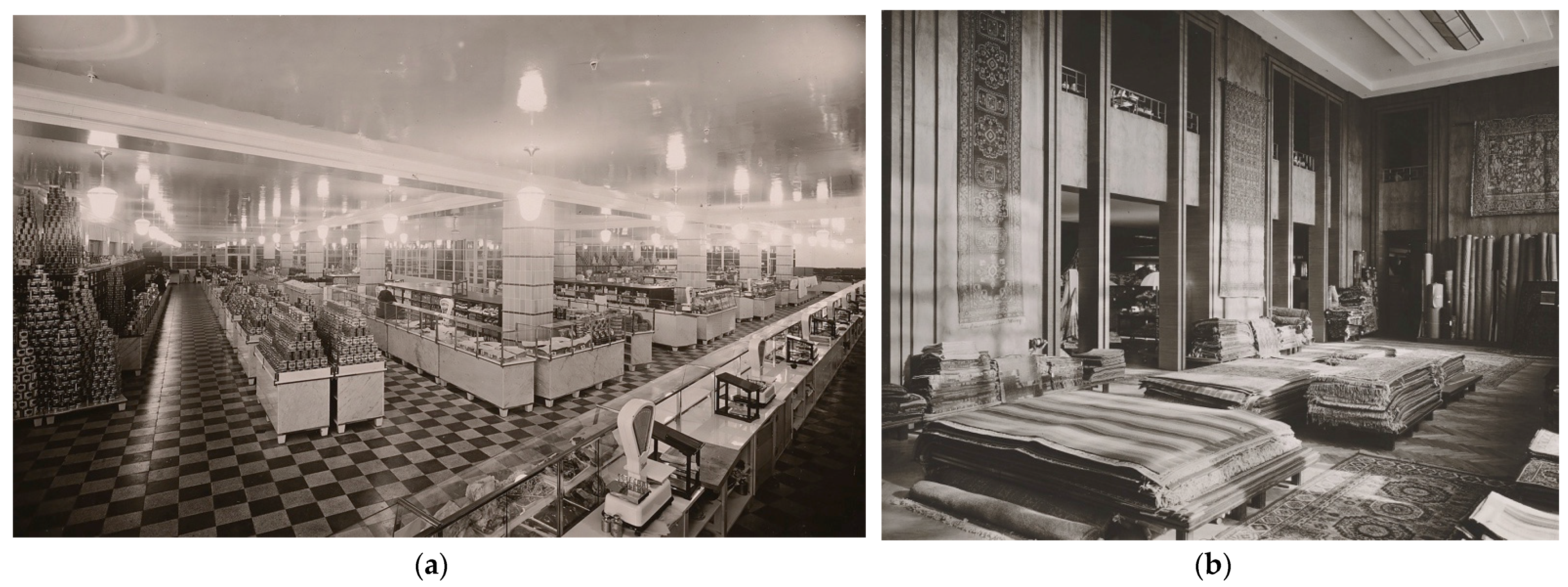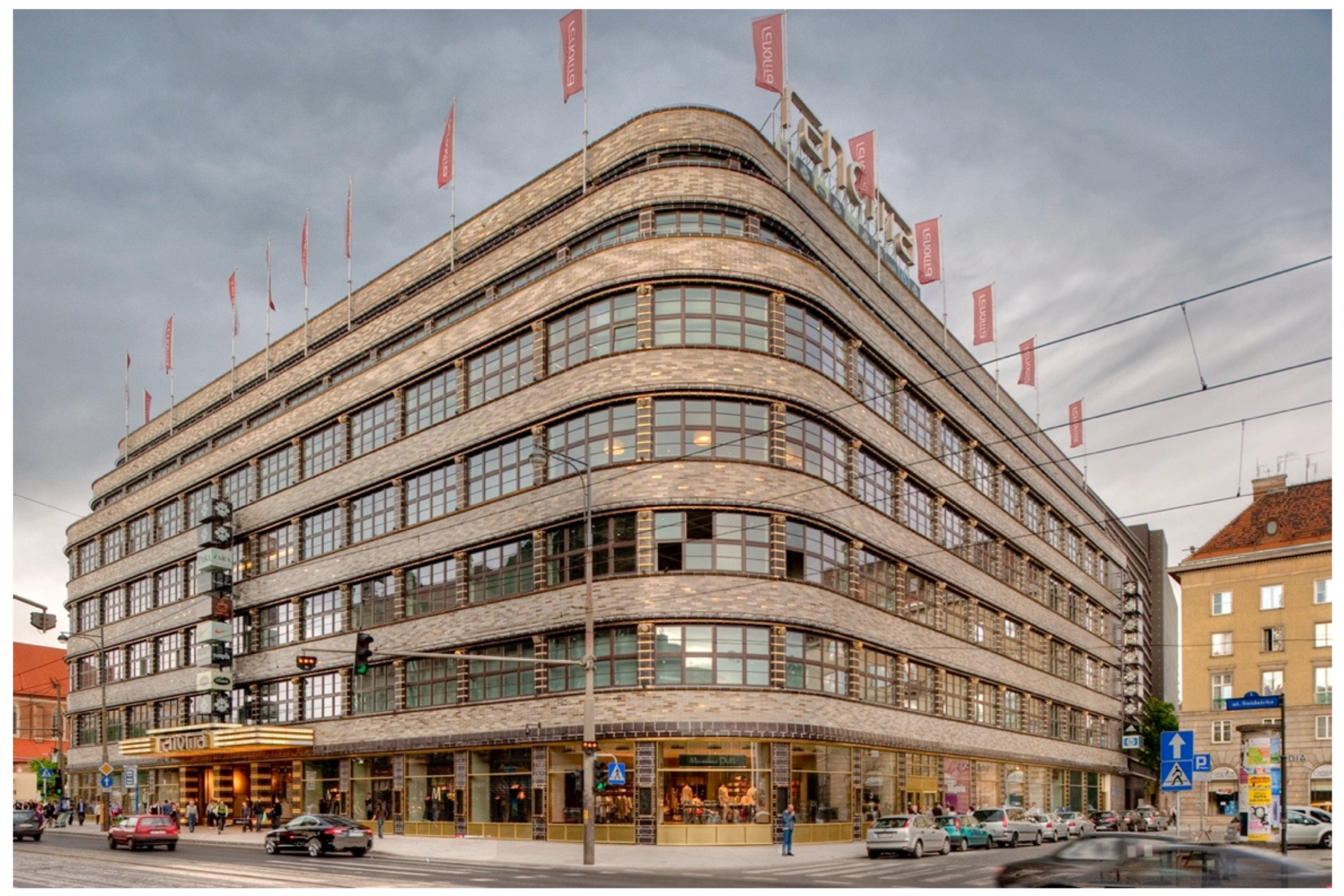1. Introduction
In Germany, the first three decades of the twentieth century were a time when different artistic currents and styles coexisted with one another. Among them was the multi-threaded International Style, referred to in German as: die Moderne, das Bauhaus, der Funktionalismus, die Neue Bauten, die Neue Sachlichkeit (
Giedion 2009;
Pevsner [1936] 2005;
Adams 2017;
Seelow 2017). Its more or less geometricised and decorative mutations were referred to as Expressionismus, Backsteinexpressionismus and Streamline Moderne (
Hillier [1968] 1985;
Tołłoczko 2010;
Wereszczyńska 2015). There also existed a luxurious, decorative and colourful variation, which over time became classified as Art Deco or Art Moderne, which used the revolutionary achievements of Modernism in relation to the functio-spatial structure and structural system, while also demonstrating innovation in massing, colour and ornament composition (
Bayer 2012). These types of luxury solutions were distinctive of commercial buildings, especially department stories (
Lerner 2015;
Schuldenfrei [1913] 2018;
Merwood-Salisbury 2019). Another key element in their composition and functioning was the potential offered by artificial lighting, which was decisive in the structure of interiors and provided innovative capabilities in exposing the architectural composition of facades (
Hilberseimer 1929;
Riezler 1927).
It is difficult to clearly demarcate the period of building commercial facilities in the various currents of Modernism, especially in Expressionism, Streamline Moderne and Art Deco. Precursory service buildings with a functional spatial structure and expressive facade and interior composition, with an exposed structural system and geometricised decorative elements made of stone, concrete or ceramics, were already being built in the 1910s (
Ilkosz and Störtkuhl 2000;
Klebs 1977). The beginning of the 1920s, riding the wave of societal renewal after the First World War, was a period of theoretical and formal exploration, which a number of years later produced commercial and public buildings in expressive conventions that formed the seed for the Streamline Moderne style (
Haspel 2010). In the Weimar Republic, the peak in constructing commercial buildings in luxury versions of Modernism and Expressionism with admixtures of Art Deco came in the second half of the 1920s, which was associated with a short-lived period of economic prosperity (
Atkinson 1928). Initially, due to limited financial capabilities and a lack of free plots in city centres, older structures were remodelled to fit the convention, and after the economy sped up in the years 1927–1930, a range of Geschäftshaus- or Kaufhaus-type buildings were constructed, with a small range of Warenhäuser (
Kiepke 2017;
Kirschke et al. 1997). Their architecture, maintained in a Streamline Moderne spirit, had functionalist features with Messel and Expressionist accents.
The structure of such department stores implemented functional and spatial solutions fine-tuned by large companies, which optimised customer service and safety, while paired with monumental forms and luxury decorativeness of selected areas of facades and interiors. When combined, it was to provide the public with a comfort of use and a sense of ennoblement stemming from participating in a type of spectacle, forming a peculiar form of popularising Modernism in its luxury variations (
Coles 1999;
Atkinson 1928). It should be noted that this period of construction prosperity began immediately after The International Exhibition of Modern Decorative and Industrial Arts (
Exposition Internationale des Arts Décoratifs et Industriels Modernes) in 1925, which popularised art Deco (
Brunhammer 1976;
Chandler 2021a). Germany itself was not represented at the exposition, yet the sophistication of the style was also well-received there. It led to the reorientation of pre-existing expressive architectural currents towards a greater decorativeness and vividity, which manifested itself in a range of large commercial buildings. It became reflected in the material structure and colour schemes of facades, which began to feature immense glazings, brass and colourful glazed ceramics, sandstone, travertine, Muschelkalk and concrete (
Hennig 1925–26;
Hahn 1925;
Häring 1928;
Snethlage 2011;
Siegesmund and Török 2011). A decline of these types of projects came about in Germany after the global financial crisis of 1929, when many American and German banks collapsed, which resulted in only a handful of already ongoing projects being completed with great effort, with some funds being redirected towards commercial and office buildings (
Stommer 1990). After Adolf Hitler’s rise to power and the establishment of the Third Reich in 1933, a period of National-Socialist architecture began (
Uhlig 1956).
In other countries, such as the United Kingdom, the Netherlands, Belgium, Switzerland or Norway, buildings in expressive and luxury currents of Modernist architecture were built for a decade longer. In the case of the United States of America, commercial and service buildings in the Art Deco style were built up to the 1950s, which can be linked with, among other things, the migration of many Jewish European architects across the Altantic, who were fleeing from Nazi persecution. They included such accomplished figures as Erich Mendelsohn, Mies van der Rohe, Walter Gropius or Walter Kurt Behrend (
Telesnik 2018;
McGuire 2019).
The subject of this paper is a presentation of the results of a study on the theoretical assumptions concerning the architectural composition of commercial buildings erected in the years 1927–1930 in Berlin and contemporaneous Breslau, with a focus on precursory solutions from the German Empire period and the initial years of the Weimar Republic. The buildings analysed were designed by architects and artists who were educated primarily in Berlin and Munich and the most renowned from among them received commissions from big cities all over the country, especially from leading store chains. The analyses and conclusions presented in this paper are the result of the authors’ research and expert and design activity that focused on the restoration of over a dozen of Wrocław’s department stores built in the various Revival styles and those of the Secession, Modernism and Art Deco (
Kirschke 2005,
2014,
2015;
Kirschke et al. 2018). During this study, theoretical problems concerning composition and technical solutions were investigated in confrontation with solutions that were applied in Berlin buildings of similar rank and built in the period under study (
Schneegans 1923;
Weber and Güttler 1978;
Schnedler 1978;
Weiss-Sussex and Zitzlsperger 2013).
The paper’s analytical section focuses on a review of assumptions concerning the structure of Modernist department stores. They all had compact massings, cubist forms and functional spatial layouts determined by a technology intended to meet the needs of large commercial spaces, based on systems of passages or atria and a steel or reinforced-concrete structural system. The study predominantly focused on an analysis of the composition and structure of the buildings’ facades and interiors in terms of the materials applied, their specificity and colour scheme, while accounting for the effects obtained in daylight and under artificial illumination. Such a distinction was seen as important as in the period under study, architectural composition accounted for the advertisement purposes and appearance of commercial buildings after dark, when neon lights and illumination were operating (
Hilberseimer 1929). Analysis of the potential offered by the application of architectural ceramics (
Kirschke and Kirschke 2013;
Seydewitz 2008,
2013), as well as steel, concrete, artificial and natural stone, wood as well as tempered glass, copper, brass and bronze in the case of windows, was an essential theme of this study (
Paulsen 1928). The paper also presents observations and conclusions on formal courtyards (Lichthof) which were crucial to the organization of interiors, and whose interior design used alternatively noble tree species, stone or ceramics, and brass, glass, coloured stained-glass windows and mirrors (
Irrgang 1980).
The objective of the study presented above was to systematise the state of the art on the architecture of department stores built in the years 1927–1930 in Berlin and Breslau. This provided an opportunity to formulate conclusions that can optimise heritage conservation decisions and direct design work on remodelling such buildings, especially the renovation of stone and ceramic facades, as well as recreating formal interiors. This paper discusses this subject on the example of implementation studies and conservation work that accompanied with remodelling and extension of the A. Wertheim department store in Breslau (the present-day Dom Handlowy Renoma in Wrocław), whose architecture, maintained in the Streamline Moderne style, with a ceramic cladding and Art Deco detail, is unique (
Kirschke and Kirschke 2008). Over many years of investigations and analyses, it was possible to determine the building’s origins, explore its structural composition and the technology of manufacture of its ceramic facades and their colour, as well as the composition of the no-longer-existing courtyards that used to illuminate the building’s interiors, which became the basis for design decisions made during the restoration.
2. Colour and Light in the Perception of the Architecture of Department Stores Built in the Years 1927–1930 in Berlin and Breslau (Wrocław)
The crisis caused by Germany’s defeat in the First World War and the post-war inflation resulted in the pauperisation of the society of the Weimar Republic, as well as a stagnation in trade and real estate development. The economic situation began to improve in 1925, which led to the doubling of the turnover of Germany’s five largest chains of department stores, Karstadt AG, Hermann Tietz &Co, Leonhard Tietz AG, A. Wertheim GmbH and Schocken AG by 1929. These were companies that employed even up to 20,000 people and had tens of branches, erected in all of the country’s largest cities during the turn-of-the-century prosperity. Initially, commercial buildings from the imperial period began to be modernised all across Germany, yet after just a few years there began a process of constructing a new generation of department stores. However, even during the economic boom (1927–1930), the main branch of activity was still the remodelling and extension of historical buildings. This was motivated by economics and advertising (the tradition of a given area and the desire to retain clients), as well as a lack of free plots of land in the centres of large cities like Berlin, Breslau, Frankfurt or Stuttgart (
Iram 1931;
Weber and Güttler 1978). Designs were commissioned from renowned architects such as Philip Schaefer, who worked for the Karstadt chain, Erich Mendelsohn, who worked for Schocken, Herpich & Sons and Petersdorff, Hermann Dernburg, who worked for Wertheim, Seep Kaiser, who worked for C&A Brenninkmeier, or Johann Emil Schaudt and Hans Poelzig for Hermann Tietz. During this time, a range of Berlin department stores were either remodelled or extended, including the Wertheim store at Leipzigerplatz, and a new Warenhaus Karstadt was built at Hermannplatz. Several dozen Kaufhaus-type buildings or mixed-use retail and office buildings were either built or remodelled. Some of them had unique compositions, such as the Pelzhaus Herpich (Erich Mendelsohn), the Kaufhaus N. Israel (Heinrich Staumer), the Waeschekaufhaus F.V. Grünfeld (Otto Firle), the Seidenhaus Michaels (Johann Emil Schaudt), the Geschäftshaus Dierig-Stoffe (Otto Rudolf Salvisberg,) or the Konfektionshaus C&A Brenninkmeyer (Sepp Kaiser) (
Schnedler 1978;
Kiepke 2017). In the same period, a range of buildings was modernised in Breslau, including: the Warenhaus Barasch (Simon&Halfpaap), the Warenhaus Messow & Waldschmidt and the Geschäftshaus Theodor Glückmann. An enormous Warenhaus A. Wertheim was built to a design by Hermann Dernburg, in addition to several Functionalist retail and office buildings, including a C&A Brenninkmeyer building by Seep Kaiser and the Petersdorff Konfektionshaus by Erich Mendelsohn (
Kirschke et al. 1997;
Kirschke 2005).
It is Mendelsohn who should be seen as a precursor of modern German interwar commercial buildings. In his firm, which operated in Berlin in the years 1919–1933, he created still-astonishing, expressive conceptual sketches, which he then turned into technical designs of department stores that had avant-garde architecture (
Figure 1a,b).
This gained him the reputation of an outstanding Modernist, and the few surviving buildings that he designed are currently seen as priceless monuments (
Zevi 1983;
Stephan et al. 1999). Mendelsohn’s first achievement was the reconstruction of the Mossehaus, which belonged to the publisher of the Berliner Tagesblatt (
Figure 2a). The building had been damaged during revolutionary unrest in November 1919. Mendelsohn left the remaining fragments of sandstone facades and changed the structure of the corner, above which he created a rounded, three-storey, plaster-covered superstructure that descended in steps on both sides, which gave the building a futuristic appearance. The architect also innovatively introduced cladding from dark, glazed ceramic tiles near the interior. The tiles were produced by Richard Blumenfeld AG in Velten, and had black, pronounced cornices (
Seydewitz 2008,
2013). On the upper floors, a stunning effect was produced by window strips with recessed frames, a feature which had been previously only used in industrial buildings (
Mendelsohn 1924). Erich Mendelsohn also authored the avant-garde remodelling of the Pelzhaus C.A. Herpich & Sons at 9–13 Leipziger Straße, which was carried out in 1924–1927 (
Figure 2b). The new building, erected at the site of three residential buildings, became a uniform structure, whose Functional facade, featuring horizontal window strips and bright travertine walls, was enhanced by flat oriels and cornices from gleaming brass. This solution was quickly acknowledged as a model for commercial buildings erected in the Neue Sachlichkeit and Streamline Moderne styles. It is telling that the project’s completion was delayed by several years, which resulted from a lack of proper regulations, as well as the torpedoing of this innovative architecture by municipal authorities (
Stephan et al. 1999;
Stavagna 2011).
Several dozen similar modernisation projects maintained in the spirit of Streamline Moderne were carried out in Berlin (
Kiepke 2017). The Waeschekaufhaus F.V. Grünfeld at 227 Kurfurstendamm and 37 Joachimstaler Str., remodelled in 1928 by Otto Firle, deserves recognition here for its colour (
Figure 2c). The building’s three lower storeys, on a rounded corner, featured highlighted horizontal divisions formed by a strip of displays and ordinary windows separated by cornices from blue Keramikplaten. On the two upper storeys, white ceramics was applied, which had been produced by Rudolf Paul Hennig. The wall above the second-floor windows strongly protruded from the building’s surface. The entire facade was illuminated at night by blue tubular-shaped neon lamps. The use of chromed bronze on the facades and in the interiors, display windows, doors and stair balustrades produced unique effects, as the material glimmered in both natural and electric light (
Jochens and Miltenberger 2011).
During this period, experimentation with other facade materials, especially glass, was quite common in the modernisation and adaptation of housing and retail buildings. In 1927, Berlin architect Adolf Rading, then a professor of the Staatliche Akademie für Kunst und Kunstgewerbe, remodelled two townhouses located in Breslau at 2 and 3 Solny Square. A seven-storey edifice was built (the two additional storeys had a reinforced concrete structure), whose facade above the ground floor was unified via sill walls covered with bright grey panes of opaque, cast glass (Opakglas) and dark strips of loosely placed windows and spaces between them, linked with black, opaque glass. In the ground floor, which was clad in bright ceramic brick-like tiles, there were display windows topped with a wide strip that acted as a signboard, underlit and made from frosted glass, which featured inscriptions (
Figure 3a). (
Ilkosz and Störtkuhl 2019).
Lighting elements played a significant role in Rading’s proposal, especially the vertical signboard at the point of contact with the nearby bank building, which was perpendicular to the facade and featured the name of the Mohrenapotheke, created from underlit coffers with individual letters placed on a red background, as well as neon light strips located underneath windows. In Berlin, architects and brothers Wassili and Hans Luckhardt, together with Alfons Anker, built the Teleschow-Haus at Potsdamer Platz, where they used white and dark-blue plate glass (
Figure 3b) (
Schnedler 1978;
Kiepke 2017, pp. 58–61). The year 1928 also saw the completion of a facade of the Sinn department store, located in Gelsenkirchen, which was clad in malachite-coloured Opakglas panes, designed by Bruno Paul (
Boenisch 1928).
Erich Mendelsohn, having the achievements of prototypical commercial buildings behind him, engaged in completing three department stores for the Schocken company in the years 1926–1928: in Nurnberg, Stuttgart and Chemnitz. By designing the distinctive forms of these buildings, which were used in the advertisements of the company and entrenched its image, Mendelsohn became a precursor of branding in architecture (
Glancey 2015). The building in Stuttgart specifically deserves a detailed overview, as it is seen as an icon of the Streamline style. Due to its five-storey steel skeleton structure, the building had an open interior structure, enhanced with insolating courtyards. The facades were designed as predominantly horizontal due to strips of windows that varied within the facade and were framed by cornices from bright-beige Connstatter Travertin stone from the Harz Mountains (
Werner et al. 2014) and sill walls that were clad in glazed clinker which featured numerous shades of brown and red (
Figure 4a,b) (
Stephan et al. 1999;
Breuer 2019;
Werner et al. 2014). It is believed that this type of material, aplied in commercial buildings, as well as the vivid building illuminations, must have been seen by Mendelsohn during his travels in buildings by Henry van der Velde in Belgium and Frank Lloyd Wright in the US. The corner section of the department store, which housed a formal staircase, formed a rounded tower that was held by cantilevers over 3.5 m above the ground floor, with expressive divisions formed by brass cornices and continuous strips of glazing. The other Schocken buildings also gained recognition. The building in Chemnitz was especially praised for the boldness of its cantilever structure, which was closely linked with the spacing of internal columns and the facade which featured balanced relations between the horizontal layout of windows and prominent staircase shafts. The skilful reduction of the building’s mass by setting back the upper floor was also praised (
Hegemann 1930).
Mendelsohn experimented with just such a structure in Breslau in 1927, yet with a completely different form and facade material. He received a commission to remodel the Rudolf Petersdorff Konfektionshaus that had existed there since 1913. The project was tied with the building’s extension on the corner of Szewska and Oławska streets. Due to the use of a steel structural skeleton on the building’s six repeatable floors, open space interiors were formed, allowing for the arrangement of a fashion gallery, as well as offices and sewing halls on the upper storeys. In the wider facade from the side of Szewska Street, three floors were suspended by cantilevers above the ground floor, which featured enormous display windows and a glazed main entrance. The design was predominated by an alternating layout of window streets with brass frames, framed with pronounced brass cornices and sill walls from bright beige slabs of Connstatter Travertin stone (
Figure 5a,b and Figure 10b). (
Zevi 1983;
Kirschke and Kirschke 1998).
This layout was continued in the five-storey, rounded oriel that formed a dynamic accent on the building’s corner. The shorter facade referenced traditional buildings, with a flat wall perforated with regularly spaced, rectangular windows, and had its uppermost level set back. Much attention was given to the mercantile side of the building’s architecture: by enabling the exposition of products in display cases 3 m deep, and by proposing luminous advertisements. At the same time, similarly as in the three stores that belonged to Schocken, the night-time illumination of the building, which highlighted its expressive form, played an immense role in its promotion, and contributed to such buildings being seen as prototypes of so-called Interactive Architecture (
Wereszczyńska 2015;
Okur and Karakoç 2019).
Similar remodelling and extension projects that targeted department stores could be observed in Berlin. The Kaufhaus N. Israel at 9/10 Königstraße was also built in 1927, to a design by Heinrich Straumer. His architectural proposal was based on abandoning facade ornamentation, and replacing it with grey, artificial stone and a simplicity of interiors. The cornice, which protruded heavily above the display window, separated the ground floor from upper floors, which were almost identical, yet had bigger windows, placed in bronze frames (
Figure 6a). Due to retaining the structural system of the previous building, this part of the building also featured its original giant-order lesenes maintained in the rhythm of the ground floor’s columns, while the entire form was topped with a simplified entablature with a prominent cornice, which featured a strip of copper and the first-ever use of hidden strip facade illumination (
Schnedler 1978).
The interiors were Functionalist, and were accentuated by a glazed courtyard with a geometricised décor, wherein a suitable rank was achieved via the honesty and quality of the material applied (
Figure 6b and
Figure 7a). Transversely striped Cypolin marble was used as column cladding along their entire length. It had white and intensively green veining, and thick layers of mica. The undersill walls that connected the columns were decorated with matte plates of pink Fleur de Pêcher marble, which had a rick graphical effect with large structural elements. The stairwell, made of white marble, had balustrades from gilded wrought iron and bronze railings. The entirety was complemented by silver and gold moulding profiles. The illumination was designed in an impressive and innovative manner. At the centre, there was a three-storeys-high vertical chandelier, which ended in a translucent glass ball. It consisted of nine segments that consisted of clusters of frosted glass tubular lamps. The columns on the ground floor were decorated by similarly designed sconces. This illumination was designed by architect Franz Hägele and installed by Schwintzer & Gräff (
Siedler 1929;
Hägele 1927).
The Warenhaus Hermann Tietz at Chaussestraße, reconstructed after a fire in 1929, was also given a simple and functional facade. Architect Emil Schaudt exposed the facade’s enormous ground-floor display windows and the entrance, topped by a glazed cantilever canopy, located in an arcade. Above, the facade rhythm was formed by horizontal undersill walls clad with sandstone and windows strips divided by artificial stone cornices. The upper two storeys were set back in a stepped pattern (
Weber and Güttler 1978). Another case of efforts intended to modernise a large department store was the remodelling of the main entrance, courtyards and three upper storeys of the Kaufhaus des Westens (KaDeWe), which was carried out in the years 1929–1930 by the Hermann Tietz company after taking over the building previously owned by A. Jandorf & Co. Johann Emil Schaudt also acted as designer here. The new glazed main entrance was covered with a cantilever-supported, glazed and underlit roof, and the layout and décor of both courtyards was altered, while the steep roof was replaced with a vertical extension that followed a stepped pattern (
Weber and Güttler 1978).
In 1927, the complex of A. Wertheim department stores at Leipziger Straße was remodelled yet again. The design of this building, by architect Paul Kolbe, was selected via competition already in 1914, yet the war delayed its execution by thirteen years. The facade of the new Muschelkalk wing referenced the nearby monumentally composed Messel corner and its large roof with its composition. In the interior, at the centre of the floor plan, a four-storey Lichthof was placed, in addition to a second Glassüberdachthof, roofed at the level of the first floor. Within the first courtyard, all of the composition elements: simple four-storey columns, a formal staircase and the recessed balustrades of the galleries, were covered with polished walnut wood (Nuβbaumholz). The construction of wide supports in the rather narrow courtyard, despite the use of steps, resulted in them appearing excessively massive and caused openings to become narrower (
Blunk 1927;
Wertheim 1936). The interior was enlivened by three massive and colourful stained-glass windows placed in the northern wall (
Figure 7b). Motifs like stained-glass windows, mosaics, mirrors with carved ornaments, brass balustrades and sculptural compositions placed throughout the interior, commonly used in retail buildings prior to the First World War, were seen as archaic towards the end of the 1920s. Innovation, however, was associated with topping the skylight using a simple glass ceiling grid and improving the system of natural illumination. The building had six storeys, and the courtyard walls above the glass roof were stepped and set back in 2 m intervals, which admitted more light inside. Here, artificial illumination was provided by gigantic hanging lamps by Franz Hägele (
Benton et al. 2010, p. 177;
Estler-Zigler 2019). After the project was completed, the Wertheim department store complex at Leipziger Straße and Leipziger Platz became the largest complex of this type in Europe, as it had a floor area of more than 100,000 m
2 and featured over twenty courtyards with interior designs from various periods.
The only completely new department store in Berlin from the period under study was a Karstadt chain store at Hermannplatz, built in the years 1927–1929 to a design by Philip Schaefer and associates (
Weber and Güttler 1978;
Stommer 1990;
Weiss-Sussex and Zitzlsperger 2013). The enormous, Cubist building, with a floor area of 72,000 m
2 and three internal courtyards, was accentuated by two towers, each 56 m tall. The facades’ rhythmic, vertical composition consisted of seven-storey pilasters lined with bright sandstone, which creatively referenced Messel’s conceptual proposals. The rather poorly highlighted ground floor featured large display windows separated by the massive pilasters and topped with signposts, as well as a central main entrance, placed under a wide arcade. The repetitive storeys with vertical windows sported parameters that allowed for housing both retail and office spaces (
Figure 8a).
The building’s central courtyard was exceeding high, and the pilasters that formed it were clad in Muschelkalk stone (
Figure 8b). Its glass roof had a simple, horizontal layout. The building had a majestic character, which was not disrupted by advertisements typically seen in such buildings. Here, they were confined to the store’s name placed above the entrance and on the towers. The sole colour-based accent of this monochromatic composition consisted of flags placed at the building’s top. The building had an illumination that highlighted the verticality of its facades and strongly accentuated the stepped tower pinnacles that were designed in the spirit of Art Deco. It should be added that this Karstadt store had an entire array of then-cutting-edge and unique technical solutions, such as an enormous rooftop strolling terrace with greenery and lanterns, as well as a U-Bahn station in its cellars (
Wedemeyer 1929).
The Wall Street crash drastically reduced financing capabilities, which, combined with the existence of gigantic department stores erected before the First World War, led to a change in retail strategies. After 1930, this manifested itself in projects being predominated by six- and seven-storey department stores with a mixed function, simpler forms and more modest facade materials (
Figure 9a). It was observed that effective retail operations were mostly confined to the first two storeys (and sometimes also in the cellars), while above these levels one was to design an open structure that would provide freedom in the design of service establishments or office spaces. As a consequence, buildings that featured spatial, compositional, material and colour solutions that reflected their mixed use soon appeared in both Berlin and Breslau.
In Berlin, this process can be illustrated by the construction of the Columbus House, which was designed by Erich Mendelsohn in 1928 as a Galerie Lafayette department store, but was modified during construction a few years layer into a retail and office building (
Figure 9b). This building is seen as a prototype of modern, glass-and-steel architecture with uniform storeys. The two lower levels were heavily glazed, while the upper seven had horizontal window strips. A terrace and an expressively formed roof that protruded as a cantilever topped the building. Mendelsohn later claimed that he had intended to use only steel and glass in the building’s facades, yet the client had also wanted it to have marble walls where neon advertisements could be placed. As it turned out, this avant-garde architecture would find greater recognition in America than in Germany. This was contributed to by the fact that the building was opened for use in 1933, in the same month when Adolf Hitler became the chancellor of Germany (
Kunstler 2003;
Zevi 1983, pp. 124–29).
The Columbus House was a unique building. Most retail and office buildings had Cubist forms, with facades clad in sandstone, travertine or artificial stone, with a glazed ground floor, short passages at the main entrance and horizontal strips of walls and windows on the upper floor. The upper storeys were set back in a stepped pattern so as to adapt the buildings to their historical context and avoid shading neighbouring plots (
Stommer 1990) Here, floor plans designed in an extremely functionalist manner had a repetitive layout with a clearly legible reinforced skeleton structure. The ground and first floors had greater clearance heights that enabled the arrangement of sales spaces, which were typically combined with a formal staircase. The upper floors were adapted to the requirements of office work in terms of clearance height and strip window layouts. In Wrocław, examples of such buildings include two neighbouring buildings at 7 and 8a Świdnicka Street: the Kunstgewerbehaus Wilhelm Knittel (
Figure 10c). designed in 1927 by Max Strassburg and Geschäfts- und Bürohaus Bielschowsky from 1930, designed by Hermann Wahlich (
Kirschke et al. 1997).
The Geschäftshaus C&A Brenninkmeyer built at 10/11 Oławska Street in 1930 to a design by Sepp Kaiser, was a slightly larger and more complicated building (
Figure 10a). The entire ground floor of the building was occupied by a large retail space, covered by a glass roof in its central section. Along the perimeter there were display windows with bronze frames, and near the entrance, a system of deep display cases formed a type of passage. The building’s four office levels had an L-shaped floor plan, which provided good access to daylight. Along a large section of the east facade, the uppermost storey was set back, forming a narrow terrace. The building’s Modernist facades alternated between strips lined with bright travertine and large windows framed by travertine cornices. The stone-clad corner was accentuated by protruding and rounding a section of it, which referenced the oriel of the nearby Petersdorff building nearby, designed by Erich Mendelsohn (
Figure 10b). This corner and the strip above the ground floor was enhanced by linear neon light advertisements (
Kirschke 2005). As a side note, it should be added that Sepp Kaiser built a very similar C&A Brenninkmeyer department store in Berlin-Charlottenburg. Both buildings differed only in the layout of their corners and that the facades of the Berlin building were made from a cheaper material: a bright Terranova-Edelputz (a dry plaster patented in 1893 by the Terranova-Industrie company) (
Schnedler 1978, pp. 119–20).
Towards the end of the 1920s, extensive modernisation of large buildings from the beginning of the twentieth century ensued. The buildings modernized included: the Warenhaus Messow & Waldschmidt and the Geschäftshaus Theodor Glückmann at 16 Oławska Street, which had been taken over by the Hermann Tietz company and converted into a department store, as well as the Warenhaus Gebrüder Barasch at the Market Square. This last building was remodelled in the years 1928–1930 to a design by Simon & Halfpaap company (
Kirschke and Kirschke 2004). The five-storey display window was removed from the facade facing the Market Square and above it a structure based on a simple rhythm of columns and windows was introduced, which corresponded to then-predominant Functionalist ideas. The underlit advertisement globe was removed, and the illumination was modified and replaced with new accents: several neon signs, including an especially large sign with the company’s name (
Figure 11a,b). As a part of rationalising the building’s functional layout, the formal staircase was replaced with an escalator. Attempts were made to increase usable floor area in every possible way, which led to the removal of the four-storey courtyard via the addition of inter-floor reinforced concrete decks. This was a manifestation of a pan-German trend, as in the years 1925–1935 the share of buildings without internal courtyards increased from 10 to 30% (
Irrgang 1980).
The form of the building and the colour of its facades have always complemented themselves, as this increased the potential to individualise the building. In the years 1927–1933, modern commercial architecture closely tied shape with the colour of the material, placing its durability, natural colour and manufacturing quality first. These conditions were met by natural stone, ceramics, and glass, as well as high-quality concrete. The greatest colour variation, as well as the saturation and contrast of colour, was given by glass and ceramics, which could be gilded, which was seen as especially attractive in Art Deco architecture. Despite the widespread use of facade paints in housing buildings at the time especially those produced by the Adolf Wilhelm Keim company, based on so-called aquatic glass, they were mostly used in the current of so-called ‘white architecture’ of the International Style (
Kinseher 2014). In all the stylistic variations of Warenhaus and Kaufhaus type buildings, colour accents consisted of details made of ceramics or stone, and cornices, canopies and display windows out of polished brass, bronze and glass, as well as advertisements, especially colourful neon signs that caught the eye and shaped the atmosphere of main downtown streets after dark.
3. Warenhaus A. Wertheim in Breslau (Renoma Department Store in Wrocław)—A Case Study
The remodelling project of the Barasch department store discussed earlier was a reaction to the construction of a modern A. Wertheim department store in Breslau—the present-day Dom Handlowy Renoma. It was previously the subject of studies by the authors of this paper in the years 1998–2002, 2005–2009 and 2019–2021, whose findings formed the basis for its subsequent renovations (AMKZ 1998, 2005, 2006–2008, 2020). The history of the building’s construction was recreated. It was the last building to be built by the A. Wertheim company, and was completed in 1930, in a time that was exceedingly difficult in economic and political terms. In 1934, the Nazis enacted the confiscation of Jewish property and, despite Georg Wertheim’s attempts to reclassify the company as Aryan (by transferring the company to his wife), all of its department stores were nationalised in 1937 (
Fischer and Ladwig-Winters 2004). Ten years prior, the company’s financial situation had been excellent, and its future had been seen as promising. Experience gained during the construction of successive chain stores encouraged the company to deliver the world yet another unique, monumental building. This is why in 1927 a decision was made to announce a competition for the construction of a department store in Breslau.
Local architects were invited to participate: Theo Effenberger, Ludwig Moshamer and Hermann Wachlich, in addition to a number of architects from Berlin: Hermann Dernburg, Erich Mendelsohn and Werry Roth. The entries were assessed by, among others, Ludwig Hoffmann from Berlin and Fritz Behrendt from Breslau (
Sichert 1928) The winner was a former associate of Alfred Messel, Professor Hermann Dernburg, whose design was a correct implementation of the competition’s primary assumptions, but it did not display the later monumental character and formal richness of the building’s facades and interiors. These were built based on a modified technical design drafted in the years 1928–1929 in Berlin, whose drawings were signed by Hermann Dernburg (Professor Hermann Dernburg,
Berlin W. 9, Kthener Str. 38) and the Technical Bureau of Wertheim (
WERTHEIM Grundstücks-Gesellschaft m.b.H. Berlin Technisches Büro) (ABW 1929).
Breslau’s Warenhaus Wertheim occupied an entire block of historical development, had seven storeys, of which the two uppermost levels, in compliance with period construction regulations, were set back in a stepped pattern, forming shallow terraces that encircled the entire building (
Dernburg 1930a,
1930b). It can be assumed that this also referenced the ziggurat, one of the favourite motifs of Art Deco. The facade composition, following Modernist ideas, honestly depicted the skeletal structure and the building’s function as a retail facility. In forming the rounded corners and continuous cornice lines, in addition to the alternating strips of horizontal windows and undersill walls from ceramic blocks, the building was given a dynamic form distinctive of the Streamline Moderne (
Figure 12,
Figure 13 and Figure 19). The unique structure and colour scheme of the facades revealed itself when viewed from up close. The ground floor was predominated by display windows set in brass frames, regularly placed between columns clad with brown ceramics. These columns supported a continuous cornice which in its lower section was covered in polished brass that masked the compartments of roll-up grilles and canvas canopies. The main entrance from Świdnicka Street was placed under an arcade and accentuated by a cantilevered canopy, whose underside was a brass, underlit grille. The canopy’s vertical walls featured glazed coffers, between which there was a three-dimensional sign that read ‘WERTHEIM’, and on its side faces there was the company logo: a letter ‘W’ that supported the world (
Figure 14a). The columns that formed the arcade were lined with strips of brown ceramics and glass, gilded mosaic, not which foil-gilded prisms made at the Berlin-based Puhl & Wagner factory were inserted (
Fischer 1939;
Seydewitz 2013).
Floors between the first and the fourth had a unified composition, generated by horizontal wall strips with bright pastel colours, divided by dark brown cornices made from thick-walled panels with fine, white quartz grains, whose undersides were gilded. Wooden windows were placed between lesenes clad with strips of dark-brown, large-format ceramics and narrower, recessed panels, which were gilded. On the four levels, the upper section of each lesene featured a ceramic human head of supernatural size or a full-figure finial. The sculptures, numbering 156 in total, were made by Ulrich Nitschke and Hans Klakow. In 1929, Nitschke was commissioned to make 25 heads, forming a cycle entitled
Type aus aller Herren Länder, and was to make four copies of each. The heads were modelled after photographs of people of various races presented on the pages of the Atlantis magazine (
Figure 15a) (
Kirschke and Kirschke 2013). The finials, placed on the facade in a vertical layout every three axes, were inspired by pioneering macroscopic plant photographs by sculptor Karl Blossfeldt, which were first published in 1929 (
Figure 15b) (
Adam 2004). All of the sculptures were made from the same clinker clay as the other ceramic elements. They were dried and later fired two times (the last firing was performed after applying the glazing). Afterwards, gilded accents were applied—on the heads they typically covered the hair and beards in the case of male heads—and the edges of finials (
Figure 15a and
Figure 16a,b).
The largest area of the facade (the face of the walls and undersill walls) was made from glazed panels whose external dimensions were 40 × 8 cm. (
Figure 16a) They were fired by Richard Blumenfeld Velten AG, which had a wealth of tradition and a network of brickmaking plants that also covered Lower Silesia, and had suitable raw material deposits at its disposal. This guaranteed the rapid delivery of several hundred thousand elements, which had to be performed in batches, as the ceramic facing was mounted as construction progressed.
The panels were fired at a temperature of around 1200 °C and were glazed using salt during a second firing. By applying various chemical additives and changing the firing time, glazing in different shades of beige and grey, in a white, pearl, grey, bright brown, greenish and lilac hue was obtained. A small percentage of the blocks were also manually gilded after placement in the facade, so as to produce light reflections (
Kirschke and Kirschke 2008).
The internal structure of the seven-storey building consisted of enormous retail halls organised around two glazed courtyards. The flexibility of the retail spaces was provided by a steel post-and-beam structural system produced by Carlshütte AG Eisengiesserei u. Maschinenbau in what is now Wałbrzych (Waldenburg-Altwasser) (
Lion 1930). To ensure the safety of clients, the strength of the structural system was assured, a model layout of evacuation routes was delineated, equipped with hydrants, fire reservoirs and pumps. Comfort of use was provided by access to sunlight and fresh air in all spaces, optimal electrical illumination, central heating, air curtains fitted near entrances, escalators and lifts, and a suitable interior design. It was utilitarian in most retail spaces, referencing Bauhaus Minimalism, but in a range of specialised departments, in the main entrance zone and two monument Lichthofs, it was luxurious and colourful (
Figure 17a).
The entrance zone consisted of a passage surrounded by enormous display cases with rounded corners and an underlit ceiling. The frames of display windows, their undersill walls and cornices, as well as the doors and grille of the suspended ceiling were made from polished brass that was later gilded (
Figure 17b). This ornamentation was to attract customers, but it should also be added that the entrance was also functionally optimised: it provided safe evacuation, excellent information and accessibility for the disabled. A two-storey hall was designed above the entrance, which acted as an orientation point for clients (
Figure 17c). From here, one could see the retail space of the ground floor, which terminated in an escalator and passenger lifts, as well as both four-storey Lichthofs. The décor of the northern courtyard was designed by Hermann Dernburg with sculptor Ulrich Nitschke. On the columns and solid balustrades, cladding from bright-red Guibourtia wood was used (afrikanische bubinga in German), which is characterised by narrow, darkish veins, a silky sheen and an even texture. The columns were clad with panels that had a horizontal grain, while the balustrades had either a vertical or diagonal grain. The balustrades also featured sculptures of heads, the same as the ones on the facades, and rollwerk decorations. Cascading, suspended chandeliers fitted to the steel structure of the skylight were an essential decoration of the Lichthofs. They were made out of cylindrical fluorescent lamps that terminated in a metal frame, and were grouped into bundles and affixed in groups to rods that ended in glass balls. The structure of these ‘light sculptures’ showed significant similarity to the lamps installed in 1927 in Berlin’s N. Israel department stores at 9/10 Königstraβe and those of A. Wertheim at Leipziger Platz, which lends credibility to the supposition that they were also manufactured by Schwintzer & Gräff (
Dernburg 1930a,
1930b;
Hägele 1927, pp. 364–65;
Estler-Zigler 2019).
The design of the southern Lichthof was drafted by Carl Stahl-Urach. In 1928, this architect participated in the remodelling of the Art Deco Haus Vaterland in Berlin. During this modernisation project, he created a dome and its illumination that produced an illusion of movement in the style of the Coney Island theme parks (
Hilberseimer 1929;
Fejge and Wolf 1928). In Wrocław, he used bright
Pterocarpus eraniceus wood to line the interiors (Afrikanische Rozenholz or Afrikanische Palisander in German) This research found no information or iconographic materials concerning the construction of this courtyard, which is why it is not known whether it featured some special decoration. All that was found is that the design documentation in its structural cross-section, featured the possibility of suspending large chandeliers to the skylight (
Dernburg 1930a).
The key to the commercial success of large department stores from the period under study were large retail halls, wherein each department was to be optimally placed by generating layouts and décor that addressed their specificity. In the Wertheim department store, such halls, with a clearance height of almost 5 m, were distributed across four floors around the two courtyards. Support spacings that ranged from 10.5 to 13.8 m ensured that the interiors were legible. The columns, structural beams and ceilings were covered in plaster and painted white. The halls were filled with simple, glazed furniture that stood on wooden flooring. Only the grocery department used red-white checkerboard-pattern ceramic floors, and the columns were clad in two-coloured ceramic panels oriented into horizontal strips (
Figure 18a). An exceptional décor of walls lined with Caucasus walnut wood and original illumination via an elongated ceiling dome could be encountered in the carpet department (
Figure 18b). Bespoke interiors could also be found in the service facility, e.g., in the hair stylist salon, where cherry wood was used both to line the walls and make furniture. A formal restaurant hall for 400 guests located on the fifth floor, designed by E.M. Lesser, had a ceiling with facets decorated with mouldings and lining from Makassar ebony wood (
Dernburg 1930b).
In total, the Breslau Warenhaus A. Wertheim had a functional and spatial structure that was excellently suited to the requirements of large-scale retail, and an innovative composition distinctive of the Streamline Moderne style. The gigantic dimensions of the building caused to act as a landmark of major urban spaces of Breslau’s centre, attracting attention from afar via its strong and unified form, which was perceived from various directions as a form of three-dimensional sign. Upon closer inspection, the attention of passers-by would focus on the formal and material wealth of the building’s facades an their artistic ceramic details. Attention was paid to the mercantile dimension by presenting the retail offering in thirty-six panoramic display windows. The entrance zones and both Lichthofs, lined with exotic wood, were to facilitate orientation around the building and invite people into its enormous retail halls, while also giving clients a sense of luxury. The department store opened in 1930 and was a commercial success, and its depictions were constantly circulated in trade magazines and adverts, and it would go on to become the symbol of the Wertheim company, just as Schocken’s buildings had become its symbols. Due to an interplay of historical events, Breslau’s A. Wertheim department store was the last such building built in all of Germany and became a unique monotype of commercial architecture that combined the features of Streamline Moderne with a colour scheme and detail maintained in an Art Deco convention.
The Warenhaus Wertheim survived the Nazi period (it was renamed to AWAG after its aryanisation), and after being burned down, it was rebuilt in 1945 only to operate for the next sixty years as Poland’s largest department store (
Kirschke and Kirschke 2009). In the years 2005–2021 it was subjected to a series of successive remodelling and extension projects, based on designs by Maćków Pracownia Projektowa Sp. z o.o. (MPP) from Wrocław (lead designer arch. Zbigniew Maćków), with the participation of ARUP and Benoy companies from London (AMKZ 2006–2008;
Maćków and Piątek 2009) (
Figure 19).
All of these designs were prepared based on academic research and conservation guidelines by the authors of this paper, who were responsible for conservation supervision of the project. The conservation investigations and works that targeted the former Warenhaus A. Wertheim depicted the operation of a large team that consisted of investigators, designers and contractors, who implemented design by research methods, which were presented in a range of publications (
Wlezień 2009;
Kirschke 2014). This project and the excellently suited contemporary extension received recognition in the form of numerous awards. During
The World Architecture Festival-Convencions Internacional de Barcelona (CCIB) in the competition
Building of the Year 2010 the refurbishment of the Renoma was nominated in the
New and old category. In 2011, the development was nominated in the
European Union Prize for Contemporary Architecture-Mies van der Rohe Award 2011.
Since 2009, the building has been operating under the name Dom Handlowy Renoma, and since 2020 it has been undergoing another modernisation intended to adapt it to a retail and office use, caused by the collapse of traditional forms of retail due to the COVID-19 pandemic (AMKZ 2020).
4. Discussion
An investigation of Berlin and Breslau retail buildings of the Warenhaus and Kaufhaus type built in the years 1927–1930 demonstrated that their architecture, in compositional aspects, was functional and constructivist, while also being luxurious in facade detail and the décor of some of its interiors due to the buildings’ commercial character. This was suitable to the buildings’ owners who wanted them to have the proper exposure so as to gain an advantage in competing over clients, where a building’s size, its spatial structure, egalitarian service programme and affordable products played a key role. The clients also desired these elements, as while shopping they could come into contact with luxury, which was not available to all (
Bayer 2012;
Weiss-Sussex and Zitzlsperger 2013;
Schuldenfrei [1913] 2018).
The facade structure of the department stores formed a close link between their shape and the colour of their material, placing its durability, natural colour and quality of manufacture first. These conditions were met by sandstone, travertine and granite, as well as high-quality concrete and glass framed in brass. The greatest colour variation, sheen, saturation and colour contrast was provided by glazed mosaic, especially when the possibility of gilding was used. All stylistic variations also featured additional symbolic and colour accents associated with advertising: sculptures, underlit entrance canopies, flag masts and neon signs that caught the eye and formed the atmosphere of main downtown streets. After dark, illumination also played an essential role. Here, light lines and directional lights highlighted vertical accents or simply underlined interiors that were visible through the stores’ windows.
During this period, numerous architects (like Bruno Taut or Ernst May), who are not seen as great Modernists, went beyond the white facades popularised by Gropius and Le Corbusier. They were convinced that architecture can change and improve human lives and propagated a movement towards colour (
Kiepke 2017) Especially in housing architecture, they used colourful paints to model facades, so as to highlight architecture and give it an additional dimension (
Urbanik 2019, pp. 38–39). Probably in 1924 in Breslau, Max Berg (municipal architect in the years 1909–1925) prepared a lecture with the telling title ‘Grey is the colour of donkeys’ (Grau ist die Farbe der Esel). In it, he discussed the historical significance of colour in urban planning and architecture and how it can influence the psychological state of the viewer, pointing to a need for ‘building with colour’, specifically building Breslau, implied to be horrendous (
Zabłocka-Kos 2016, pp. 71–91). In other cities there were also attempts to alter the traumatic appearance of buildings after the lost war and years of economic crisis, which, independently of how they had been originally painted, were grey due to air pollution.
When one analyses the composition of the department stores presented in this paper, it should be noted that, for functional reasons, glazed doors, displays and windows with translucent panes from tempered glass occupied around 70% of their facades. In this situation, the primary colour accents consisted of frames and cornices made of polished brass. The narrow strips of facing from stone had a more neutral character, and were often obscured by advertisements. In the case of applying facing from glazed ceramics or opaque glass, a greater variety of colour appeared, sometimes even with contrast (which were equal to the palette of Keim’s paint, which was used to cover plaster). In department store interiors, only the entrance zones and Lichthofs were places where composition, illumination and colour had wooden or natural stone facings: marble, Muschelkalk or travertine, and expressive lighting. In most retail spaces, the décor was based on an honestly presented skeletal structure, covered in plaster and painted in bright colours, which was concordant with the Modernist principle of ‘white architecture’.
The construction of the Breslau Wertheim department store presented in the previous section ended in success, but the simultaneous construction of a different branch in Berlin to a design by Otto Rudolf Salvsiberg had to be cancelled due to the deepening crisis (a modified proposal was implemented as late as in 1952 (
Weber and Güttler 1978, p. 63. fig. 71). Around the same time, similar ventures by competitors also ended in failure: the Galerie Lafayette at Leipziger Platz (arch. Erich Mendelsohn) the Kaufhaus Adam at Fridrichstraße by Ludwig Mies van der Rohe and the Hermann Tietz Schoneberg store by Johann Emil Schaudt (Weber and Güttler, p. 62. fig. 67). In Breslau, an attempt to erect a Tietz store at Schweidnitzerstraße, whose conceptual design was drafted by Hans Poelzig (Hans Poelzig 2000, pp. 515–22) also ended in failure. All of these buildings were to be constructed in concordance with a scheme developed towards the end of the 1920s that assumed the use of steel or reinforced concrete skeletons that resulted in an pen interior plan, in Modernist forms or in the current of Streamline Moderne with large glazings on the facades, which showed the direction in which this type of architecture could have followed in the 1930s. However, it had no continuation, as after 1933 store owners confined themselves only to remodelling projects, especially targeting their displays, which, along with their expositions, were the best advertisement (
Iram 1931). In other European countries, the construction of retail buildings with forms that emerged in the 1920s continued. The Bijenkorf of Rotterdam from 1930 (arch. Willem Marinus Dudok) was often used as a Cubist model, while the Bijenkorf built in the Hague in 1926 was an aerodynamic alternative (arch. Peter Kramer). A late case of a building with Art Deco form that referenced the Breslau Wertheim was the Flagey erected in Brussels in the years 1933–1938, which was designed by Joseph Djongre (
Patrimoine 1994) Streamline Moderne forms could also be found at the Exposition Internationale des Arts et des Techniques Paris which took place in 1937 (
Chandler 2021b). The Pavillion de l’Marine Marchande and the Pavillion de l’Aeronautiqe (architects: Audoul, Har-twig, Gerodias) had such forms, as did the Belgian Pavilion prepared by Henry van der Vende. Its facing consisted of red ceramics, and accents: cornices, portals, and reliefs, were made from bright sandstone. In the case of Henry van der Velde, this was a direct reference to Mendelsohn’s concept (who prized the Belgian as a pioneer of the Bauhaus). At the same exhibition, the German Pavilion designed by Albert Speer had a symbolic form, distinctive of Nazi monumentalism. This confrontation showed not only a change in taste, but also the catastrophic impact of politics on architecture (
Ladwig-Winters 1999).
Modernist department stores are currently a rarity. This is a result of the destruction brought about by the Second World War, changes in ownership, state borders, the evolution of urban planning concepts and transformations in large-scale retail strategies, which was associated with the elimination of windows from retail spaces. This resulted in remodelling and demolition, which affected, among others, the department stores (or their surviving ruins that could be rebuilt) in the area of Leipziger Platz in Berlin in the 1960s. The Schocken buildings in Stuttgart (
Breuer 2019) and Bijenkorf in Rotterdam were also demolished. In present-day Wrocław, most department stores survived the war and endured long enough to be considered heritage sites and subjected to academic investigation. This facilitates their professional restoration, which enables adapting them to contemporary utilitarian requirements while retaining their architectural features and unique colour designs.


